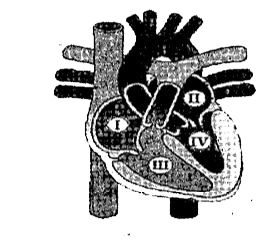of deoxygenated blood of a person is 48 mm of Hg. in this condition ,
Person experience deep breathing and sho breathing rate
Person experience no change in breathing pattem
His dissociation curve remains shifts towards left
His dissociation curve remains shifed towards right
The correct Answer is:D
To solve the question regarding the pCO2 of deoxygenated blood being 48 mm Hg, we need to analyze the implications of this elevated level of carbon dioxide in the blood and how it affects breathing patterns and the oxygen dissociation curve.
1. Understanding pCO2 Levels:
- The normal pCO2 level in deoxygenated blood is approximately 45 mm Hg. A level of 48 mm Hg indicates an increase in carbon dioxide concentration in the blood.
2. Effects of Increased pCO2:
- An increase in pCO2 leads to a rise in hydrogen ion concentration (H+) due to the formation of carbonic acid (H2CO3), which dissociates into bicarbonate (HCO3-) and H+. This results in a decrease in blood pH (acidosis).
3. Breathing Rate:
- The body responds to increased levels of carbon dioxide by increasing the breathing rate. This is because the respiratory center in the brain is stimulated by higher pCO2 levels, prompting deeper and faster breathing to expel more CO2 and bring in more oxygen.
4. Oxygen Dissociation Curve:
- The oxygen dissociation curve represents the relationship between the partial pressure of oxygen (pO2) and the saturation of hemoglobin with oxygen.
- When pCO2 levels rise, the curve shifts to the right. This is known as the Bohr effect, where increased CO2 and H+ concentration reduce hemoglobin's affinity for oxygen, facilitating oxygen release to tissues.
5. Conclusion:
- Given the elevated pCO2 level of 48 mm Hg, the person will experience an increased breathing rate, and the oxygen dissociation curve will shift to the right. Therefore, the correct answer to the question is that the O2 dissociation curve remains shifted towards the right.
Final Answer:
The correct option is that the O2 dissociation curve remains shifted towards the right.
---
- The normal pCO2 level in deoxygenated blood is approximately 45 mm Hg. A level of 48 mm Hg indicates an increase in carbon dioxide concentration in the blood.
- An increase in pCO2 leads to a rise in hydrogen ion concentration (H+) due to the formation of carbonic acid (H2CO3), which dissociates into bicarbonate (HCO3-) and H+. This results in a decrease in blood pH (acidosis).
- The body responds to increased levels of carbon dioxide by increasing the breathing rate. This is because the respiratory center in the brain is stimulated by higher pCO2 levels, prompting deeper and faster breathing to expel more CO2 and bring in more oxygen.
- The oxygen dissociation curve represents the relationship between the partial pressure of oxygen (pO2) and the saturation of hemoglobin with oxygen.
- When pCO2 levels rise, the curve shifts to the right. This is known as the Bohr effect, where increased CO2 and H+ concentration reduce hemoglobin's affinity for oxygen, facilitating oxygen release to tissues.
- Given the elevated pCO2 level of 48 mm Hg, the person will experience an increased breathing rate, and the oxygen dissociation curve will shift to the right. Therefore, the correct answer to the question is that the O2 dissociation curve remains shifted towards the right.
The correct option is that the O2 dissociation curve remains shifted towards the right.
Topper's Solved these Questions
- BOOK - PHYSICS WALLAHCHAPTER - BREATHING AND EXCHANGE OF GASES EXERCISE - NEET Past 10 Year questions26videos
BREATHING AND EXCHANGE OF GASES
- BOOK - PHYSICS WALLAHCHAPTER - BREATHING AND EXCHANGE OF GASES EXERCISE - NEET Past 10 Year questions26videos
BREATHING AND EXCHANGE OF GASES
- BOOK - PHYSICS WALLAHCHAPTER - BODY FLUIDS AND CIRCULATIONEXERCISE - NEET Past 10 Years Questions28videos
BODY FLUIDS AND CIRCULATION
- BOOK - PHYSICS WALLAHCHAPTER - CELL : THE UNIT OF LIFEEXERCISE - NEET Past 10 Years Questions64videos
CELL : THE UNIT OF LIFE
Similar Questions
Knowledge Check
- Question 1 - Select One
In humans , deoxygenated blood flows from:
ALeft auricle to left ventricle during auricular systoleBRight auricule to right ventricle during atrial systoleCRight ventricle to aorta during ventricular systoleDPulmonary vein to left auricle during auricular systole - Question 2 - Select One
In frog, deoxygenated blood is received by
ASinus venosusBLeft atriumCVentricleDTruncus arteriosus - Question 3 - Select One
Deoxygenated blood from wall of heart is carried by
ACoronary sinusBInferior vena cavaCSuperiour vena cavaDPulmonary artery


